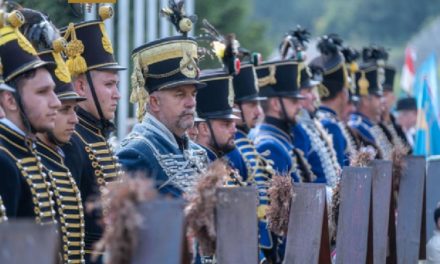Colonel Dr. Tamás Bali is the commander of the 86th Helicopter Brigade of József Kiss of the Hungarian Armed Forces. He organized and managed the helicopter assistance provided by the Hungarians in the flood situation in Slovenia at the beginning of August. In the interview, he also talked about the disaster prevention work of the national defense and the world of helicopter pilots, unknown to most of us.
At the beginning of August, Slovenia was hit by the worst natural disaster in the last thirty years. In connection with the huge flood, however, we saw not only the dramatic images in the news, but also the fact that the Hungarian Armed Forces provided large-scale helicopter assistance to the neighboring state. How is an international request for help received, and what steps follow one?
All international requests come through multiple channels. There is a political level: when a disaster situation develops in a state, the head of state directly visits the states that can provide assistance. At the same time, a disaster prevention work starts in the given country, which is the task of the national defense in Slovenia, as in Hungary, so the general staff of the national defense also contacts the military leaders of the neighboring countries. There is also a third line: there is an organization at NATO headquarters in Brussels to which nations can turn with requests. In the present case, Slovenia turned to them with the request that the member countries provide air transport capacity for them.
We received the request on all three lines, the Minister of National Defense gave a nod, and then the technical approach communication began in the National Defense. Then we had to decide exactly how we could help. Since air assistance was requested, the matter was referred to the Air Force, and from then on it was my task to organize the availability of the specified number of operable helicopters and the appropriate number of people on the given days. In such cases, the work is carried out together with the commanders of the aviation battalions and the technical battalions. It was necessary to act quite quickly, as it was a rescue operation.
In this case, under what personal conditions did they start, after how long did they arrive in Slovenia, and what exactly did they have to do there?
The negotiation started at eleven o'clock on Sunday morning, and at six in the afternoon our helicopters were already in Nagykanizsa. We went with two helicopters, the base was all the way in Nagykanizsa. We are also prepared for rescuing people and transporting goods. In similar disaster situations, food delivery is often the main task, and in this case there were also areas that were temporarily completely closed off from the outside world. We delivered food and medicine here, and delivered the shipment with a winch. We can deliver seven hundred kilos of food in two hours, and we flew for fifty hours, so we were able to deliver a huge amount of food.
Moreover
we saved two elderly people who otherwise would have most certainly died, and we were also able to take a pregnant woman from one of the closed areas, whose labor had begun.
What kind of tasks do helicopter soldiers usually have?
We have military and disaster relief jobs. The former are very diverse, mainly national defense tasks. This is often shown in the transport and evacuation of ground forces, for example, if necessary, we transport injured soldiers to medical facilities.
Among our disaster prevention tasks, in addition to rescuing people, we sometimes take part in firefighting. It is interesting that we just put out a fire a year ago, also in Slovenia. Then it was not the flood, but the extreme drought that caused the disaster. Here, too, we primarily have firefighting and embankment strengthening tasks. In case of interrupted charging, we are also responsible for replacement.
Even as lay people, we perceive that climate change results in extreme weather conditions. Has the number of your works related to natural disasters increased in recent decades?
There are more and more fires, mainly in the areas between the Danube and Tisza, in the Kiskunság National Park, and in the Hortobágy area. Of course, there have been fires in the past, but not as many as in recent years. There is also more extreme rain than in the past. The amount of water that caused a serious problem in Slovenia also mostly flowed through Hungary, there could have been a problem here as well, but in most places due to the embankments, the unusually high amount of precipitation did not cause a problem.
We also see rescue helicopters, police and military helicopters in the sky from time to time. Is there interoperability between responsibilities, for example in connection with the performance of disaster prevention tasks?
Unfortunately, disaster management does not have its own helicopter fleet, so all disaster management flight tasks belong to us. Police and air ambulance have completely different helicopters. The rescue helicopters have to land, and the injured person has to be loaded into the vehicle on a stretcher, in contrast to our winch rescue machines, which can be used to rescue without landing. The task of police helicopters is surveillance – they use serious sensors to scan the highways, for example, thus filtering out speeders – these machines are not suitable for rescue.
Their helicopter brigade is named after József Kiss. Who was he, why was the only Hungarian helicopter brigade named after him?
József Kiss was a World War I pilot who stood out from the rest not only with his extraordinary talent, but also with his unique philosophy. The gist of it was that
sharply separated the concepts of enemy and opponent. He testified that while we destroy the former, we defeat the latter.
In sharp situations, he did not regard all people as enemies, but as adversaries, he forced the pilots to the ground with his technical feats, and never killed anyone. In the end, his plane was shot down on the Italian front, and he died there at the age of twenty-two, as the most successful pilot of the Imperial and Royal Air Force, with nineteen confirmed aerial victories behind him. His philosophy had such a great impact that it is still taught as a basic principle in primary schools in Italy. Unfortunately, the name of József Kiss is not well known in Hungary, but since 2007, the then helicopter base, today's helicopter brigade, has been called that.
In June, the Honvédség organized a flight camp for young people. Who can apply for such an event, and how did these five days go?
The Hungarian Armed Forces have a contractual relationship with schools that teach basic military knowledge as a subject. This is called the military cadet program, the students participating in it are military cadets. The air camp is for them, so a kind of military training is required to apply. Here, in Szolnok, there is not only a military airport, but also a civilian one. And the aviation association here is a kind of paramilitary association, both soldiers and civilians fly here. From the point of view of the camp, all this is important because the Sports Association and the Helicopter Brigade organize camps together, so we organized this event for the cadets together.
In addition to getting to know the life of the helicopter brigade, they could fly in gliders and motorized gliders, while of course they met soldiers, and they could get a lot of information about the lives of soldiers and airmen. We also took them to Kecskemét, where they could get to know the aviation brigade there, and see the gripens and the falcon. In addition, there is an aviation museum in Szolnok, RepTár, which is operated jointly by the Hungarian Armed Forces and the city of Szolnok. Guided tours of the exhibition are available to anyone, and campers can also learn about the history of the air force here, especially in the context of an experiential tour. The essence of the camp is that there is flying every day, and they also receive theoretical knowledge that even helps clarify whether they really choose this field later.
The military aptitude test is known to present applicants with serious physical tasks. Besides, what does someone who specifically wants to fly go through?
Applicants take part in two types of career aptitude tests, which have very specific aspects. The military career aptitude is the same as for everyone else, and those who want to join the aviation unit must pass a three-day examination in Kecskemét. This is a complex medical examination: ophthalmology, otolaryngology, and swivel chair balance tests are undertaken for the applicants, but their internal medicine, neurology, and psychological conditions are also assessed. Those who pass this can start the training.
How many helicopter soldiers does the Hungarian Armed Forces currently have? How can we imagine the lives of pilots, how much time do they spend in the air, what do they do when they are not flying?
About 80 of the helicopter brigade's 1,200 soldiers are pilots, who fly about 250 hours a year. In addition, we have many other tasks that are essential for a safe flight. During our studies, we study aerodynamics, air navigation, and meteorology at a very serious level, but this knowledge wears out, which, on the other hand, cannot be allowed, because it may be necessary to call it up at any time. That is why every pilot updates his knowledge of the wear and tear during the time he is not in the air. In addition, it should be known that maintaining our physical condition is the key to our work: the success of each rescue depends on our health, so maintaining health is essential, and even part of the job for pilots. For example, during the rescue in Slovenia
we saved continuously from eight in the morning to nine in the evening, in extreme temperature conditions.
That's thirteen hours of serious physical work at a stretch. Since we are under such physical and mental stress, we must be physically, mentally and spiritually healthy.
Featured image: Hungarian Defense Forces József Kiss 86th Helicopter Brigade












